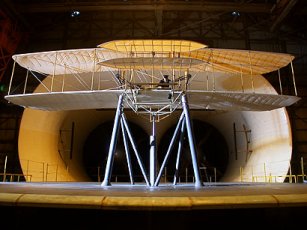December 11, 2003
When a historically accurate reproduction of the 1903 Wright Flyer airplane tries to fly on the 100th anniversary of powered flight, it will have passion, modern engineering science and NASA wind tunnel test results helping it aloft.
Ken Hyde, founder of the Wright Experience in Warrenton, Va., has passionately worked for years to uncover the secrets of Orville and Wilbur Wright, the Ohio bicycle maker brothers credited with making the first successful powered flight.
Hyde and his team have painstakingly recreated propellers, gliders and aircraft in an attempt to figure out how the Wright brothers flew for 12 seconds in 27 mph winds over the sand dunes of North Carolina's Outer Banks on Dec.17, 1903. They will get their chance next week at the First Flight Centennial Celebration near Kitty Hawk, N.C.
"We have been working almost 10 years on the research aspect of this," Hyde said. "The machine we plan to fly is three years in the building. I have often been asked why we are doing it. The answer is because nobody has done it, and it needs to be done."
Four years ago Hyde turned to NASA's Langley Research Center (LaRC) in Hampton, Va., and Old Dominion University (ODU) in Norfolk, Va., to better understand the engineering science behind the Wrights' efforts.
Hyde started by bringing wooden propellers, hand crafted to Wright specifications, to the Full Scale Wind Tunnel, owned by LaRC and operated by ODU. Hyde progressed to authentic reproductions of two Wright gliders and the Wright Flyer reproduction. ODU engineering professors and students tested the equipment.
"The Wright propellers were 20 years ahead of their time," said Professor Robert Ash, Wright test program manager for ODU. "They were able to convert engine power into thrust with the efficiency required to enable a small and heavy gasoline engine to propel the Wright Flyer. The December 17, 1903, flight was not possible without the Wright propeller designs, and this contribution has been largely overlooked," he said.
According to Ash, what the Wrights didn't do was design a stable aircraft. He and others studied hours of wind tunnel test data from the two Wright gliders and the reproduction to reach that conclusion. "Just like their bicycle heritage, the Wrights deliberately exploited instabilities to effect dynamic flight control," Ash said. "Flying the Wright Flyer is like trying to keep a bicycle upright in three dimensions."
The nature of the aircraft affected the way the four Wright Experience pilots trained. They've gotten expert guidance from a simulator, created using the LaRC Full Scale Tunnel data, and from a former NASA test pilot, Scott Crossfield. Crossfield was the first American to fly at twice the speed of sound, more than 50 years ago.
"They're all very capable aviators," Crossfield said. "But they've had to unlearn most of what they know about flying stable airplanes. Very few people have flown unstable airplanes."
One of the aviators is Kevin Kochersberger, an associate professor from the Rochester Institute of Technology in Rochester, N.Y. He helped manage most of the wind tunnel tests. During training in North Carolina last month, he successfully got the Flyer reproduction off the ground.
"Being a scientist and engineer are important qualifications for flying this aircraft," said Kochersberger. "I've been looking at the characteristics of the Wright Flyer for four years. Being in the wind tunnel with it really made a difference."
The First Flight Centennial Celebration runs Dec. 12-17 at the Wright Brothers' National Memorial in Kill Devil Hills, N.C. It will feature the Wright Flyer recreation flight, appearances by NASA astronauts and agency exhibits.
For information about NASA and the Centennial of Flight on the Internet, visit:
http://www.nasa.gov
Contact:
Michael Braukus
Headquarters, Washington
202-358-1979)
Kathy Barnstorff
Langley Research Center
Hampton, Va.
757/864-9886)
Jennifer Mullen
Old Dominion University
Norfolk, Va.
757-683-3580
|